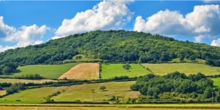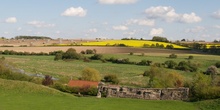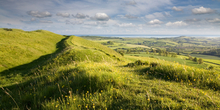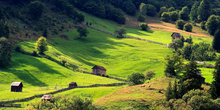Agriculture & Land Management
Our Work
Latest in Delivering Public Goods
-
The PEGASUS project publishes its first Newsletter
Welcome to the first newsletter of the PEGASUS project! It provides information on the project’s progress to date and details on the 34 case studies currently underway in 10 EU countries examining how to ensure the improved delivery of public goods and ecosystem services in different farming and forestry situations.
-
Improving environmental financing via result-based agri-environment measures
A new article by IEEP explores the use of result-based agri-environment measures in the region of Baden-Württemberg, Germany. The study shows that result-based schemes can increase the environmental effectiveness and conditionality of the EU Common Agricultural Policy.
-
CAP greening: what are its environmental prospects?
A significant injection of money was agreed for ‘green’ farming practices under the recent CAP reform. This report examines the environmental impact these measures are likely to have on the ground and concludes that Member States’ implementation choices appear to have much diminished the chances of the greening measures delivering significant additional environmental benefits.
-
New PEGASUS website
Project website for EU research project PEGASUS goes live!
-
EU research project PEGASUS - new thinking on sustainable land management
EU research project PEGASUS kicked off in London on 29-30 April. The three-year project, led by IEEP, is focused on transforming land management approaches in the EU to improve the delivery of public goods and ecosystem services from rural areas.
-
Sustainable intensification of European agriculture
The concept of sustainable intensification has come into prominence in the context of global food security. This report defines what we mean by sustainable intensification, explains its global logic, discusses what it means for EU agriculture and exemplifies this in three case studies for soil performance, nutrient recycling and biodiversity.
-
High Nature Value farming throughout EU-27 and its financial support under the CAP
This study reviews Member States’ estimates of the extent of HNV farmland and use of RDP measures and the CMEF indicators, then identifies future priorities for CAP support for HNV farming and discusses the support opportunities under the reformed CAP. It offers detailed new evidence about the combined effect of Pillar 1 and Pillar 2 CAP payments on the economic and environmental viability of a typical HNV farming system in three Member States.
-
New report: High Nature Value Farming in the EU
Member States need to make the most of the opportunities under the new Common Agricultural Policy if the declines in HNV farming, critical for meeting our 2020 biodiversity targets, are to be halted.
-
Options for sustainable food and agriculture in the EU
How should Europe respond to the increased demands on our food and agriculture systems arising from global population growth, changing diets, and competing demands on agricultural land? This report offers a view on how the EU could play a role in meeting these challenges in the coming decades and sets out some of the options which merit particular attention.
-
Europe’s role in feeding the world in 2050
IEEP presents views on how Europe should respond to the increased demands on our food and agriculture systems arising from global population growth, changing diets, and competing demands on agricultural land.
-
Assessing Scotland’s progress on the environmental agenda
How much progress is Scotland making on the environmental agenda? Can Scotland fulfill its growing aspirations to become an environmental front runner in Europe? This new report explores these questions in relation to the farmed environment, Marine Protection Areas and climate mitigation.
-
Sustainable management of natural resources with a focus on water and agriculture
Can sustainable management of natural resources in Europe’s agricultural sector contribute to sustainable water use? What other sectors have a role to play in significantly improving water use across Europe and what are the good practices and tools that are available? A new report for the European Parliament explores these questions.
-
IEEP reports to the Science and Technology Options (STOA) Panel of the European Parliament
Recycling for bioenergy and options for climate-resilient agriculture which benefits biodiversity: presentation to the Science and Technology Options Panel of the European Parliament
-
Environment undermined in CAP deal
An attempt by the European Commission to place the environment more centrally within agricultural policy has been comprehensively watered down in the final agreement.
-
Natural capital in a Nordic context
A report for the Nordic Council of Ministers reviewing five different approaches to natural capital accounting and exploring their links with biodiversity and ecosystems.
-
Land as an Environmental Resource
How can we meet the different and often conflicting demands we make on our limited supply of rural land in Europe? A more strategic approach to the way in which land is used is needed than has been the case in the past. This report for DG Environment looks at the data, the challenges and the policy options for Europe.
-
A greener CAP: still within reach?
The greening of the CAP hangs in the balance in the final negotiations; a synthesis of key issues and requirements.
-
Principles of Double Funding
This briefing explores the issue of double funding in relation to the CAP reform debate and considers the implications for delivering added value for the environment.
-
EP vote must not undermine a greener CAP
A decade’s progress in improving the Common Agricultural Policy’s environmental credentials risks being lost if the EP vote to water down the Commission’s ambitious proposals to green the CAP.
-
Land Stewardship in England post 2013: CAP greening and agri-environment
What will the introduction of environmental measures in Pillar 1 mean for agri-environment schemes in the future? A topic of much debate as part of the CAP reform negotiations, this new report explores the potential impacts of greening Pillar 1 on England’s entry-level agri-environment scheme and how a future scheme could be designed to deliver more for the environment and ensure the long term sustainability of farming.
Highlights
-

CAP greening: what are its environmental prospects?
A significant injection of money was agreed for ‘green’ farming practices under the recent CAP reform. This report examines the environmental impact these measures are likely to have on the ground and concludes that Member States’ implementation choices appear to have much diminished the chances of the greening measures delivering significant additional environmental benefits.
-

Natural capital in a Nordic context
A report for the Nordic Council of Ministers reviewing five different approaches to natural capital accounting and exploring their links with biodiversity and ecosystems.
-

Land as an Environmental Resource
-

Redesigning the CAP to deliver public goods
-

Public Goods and Public Intervention in Agriculture
